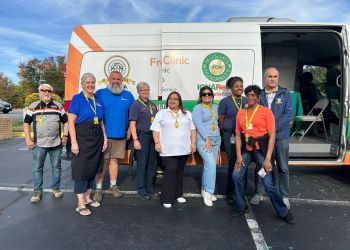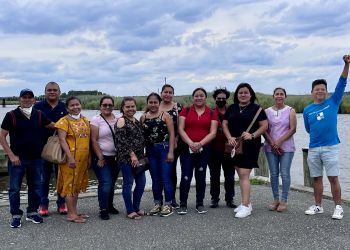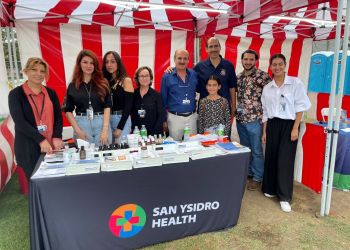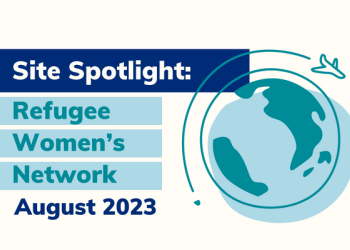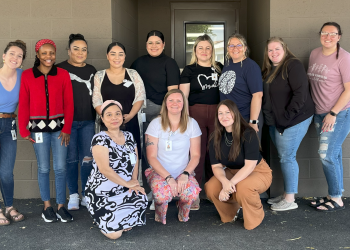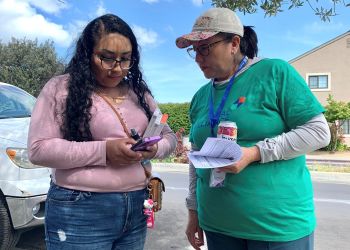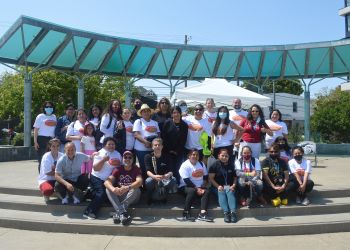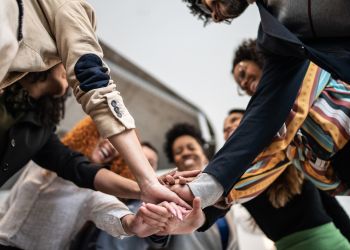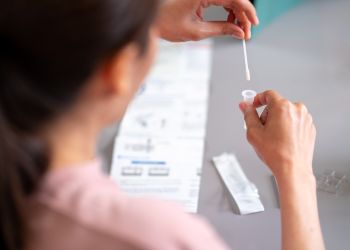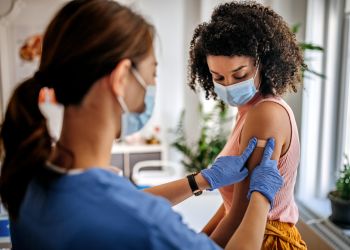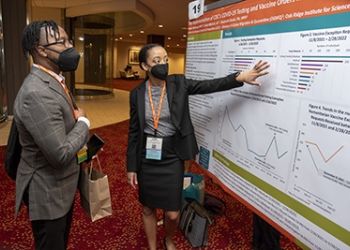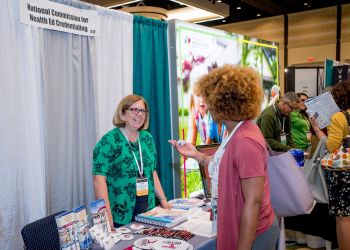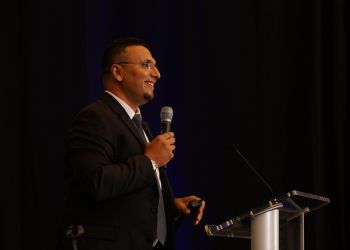Refugee, Immigrant, and Migrant Programs
Refugee, immigrant, and migrant (RIM) populations include people residing in the United States who were born in another country. There is significant diversity among RIM populations, who come from all over the world with different languages, experiences, and cultural practices and who have spent varied amounts of time in the United States and have different immigration statuses.
NACCHO’s RIM portfolio seeks to strengthen the public health system that caters to RIM communities. The program offers comprehensive support and technical assistance to Local Health Departments (LHDs) and Community-Based Organizations (CBOs), instrumental in facilitating direct health services at the local level.
The RIM program fosters and fortifies sustainable partnerships with RIM communities, through collaboration and community engagement, to better understand the barriers, and ensure health programs are accessible and align with the cultural, social, and economic needs of these communities.
NACCHO RIM and its partners are dedicated to identifying and disseminating health communication and education resources that respect the diversity of cultures represented in RIM communities. Resources range from translated health brochures, informative webinars, and interactive community workshops to virtual communities of practice.
NACCHO’s RIM portfolio is composed of; 1.) The Strengthening COVID-19 Mitigation and Prevention Strategies among RIM Communities and 2.) Strengthen Local Public Health among Afghan RIM Communities.
Strengthening COVID-19 Prevention and Mitigation Strategies among Refugee, Immigrant, and Migrant (RIM) Communities
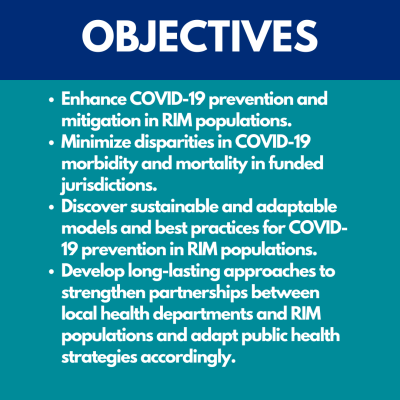
RIM populations have been disproportionately impacted by COVID-19 morbidity and mortality due to language and cultural barriers, occupational hazards, greater prevalence of underlying health conditions, structural racism, xenophobia, fear or distrust of government/health systems, unfamiliarity accessing US public health and healthcare systems, all of which make it difficult to understand, and follow standard public health guidance. To ensure the success of COVID-19 prevention and mitigation strategies and to address inequities in COVID-19 morbidity and mortality experienced by RIM communities, LHDs need strong and sustained community partnerships, experienced human resources, cross-program infrastructure to support logistics for testing and vaccine delivery at scale, and planning, evaluation, and financial management capacity. This program supports LHDs to strengthen partnerships with RIM communities in their jurisdictions and to collaboratively design, implement, and evaluate innovative and sustainable approaches to prevention of COVID 19 and other communicable diseases. This program seeks to implement and disseminate models and best practices for COVID-19 health-communication, community engagement, and strengthening partnerships between LHDs and RIM populations.
NACCHO is supporting the following sites:
- African Chamber of Commerce
- Asian Health Services
- Cameron County Public Health
- Canal Alliance
- Cass County Health Department
- Centro de los Derechos del Migrante, Inc
- Champaign Urbana Public Health District
- Chicago Workers Collaborative
- Douglas County Health Department
- Korean Community Center of the East Bay
- Mission Economic Development Agency
- Nuestra Comunidad
- Public Health Dayton & Montgomery County
- Refugee Women’s Network Inc
- San Ysidro Health
- TriCommunity Mediation
- United Community Action Partnership
- United Way Fresno and Madera Counties
Strengthening Local Public Health among Afghan Refugee, Immigrant, and Migrant (RIM) Communities
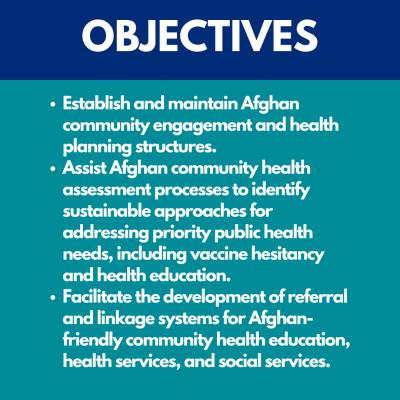
The ongoing humanitarian crisis in Afghanistan has led to a significant influx of Afghan refugees to the United States. While initial support from resettlement agencies helps provide housing, healthcare, employment, and education, these communities require ongoing access to comprehensive services, including physical and mental health support, beyond their initial resettlement period.
Culturally appropriate health communication resources in Dari, Pashto, and Farsi, as well as culturally competent mental health services and access to social services, are critical for these communities. (LHDs) serve as chief health strategists for their jurisdictions, coordinating a network of partners and providing a gateway for Afghan refugees to access various community-based and government services.
To provide culturally and linguistically competent public health services to Afghan and other RIM communities, LHDs need strong community engagement, outreach structures, effective linkage and referral relationships with diverse community partners, experienced human resources drawn from the communities they serve, and planning, evaluation, and financial management capacity. The program further aims to strengthen LHDs and CBOs efforts to collaboratively improve public health outcomes for Afghan RIM communities.
NACCHO is supporting the following sites:
Site Spotlights
If your site is interested in being featured in our monthly newsletter, reach out to Grace Murtha ([email protected]).
The RIM program offers robust support and technical assistance through a diverse collection of tailored resources to boost sustainability and inclusivity of public health efforts within RIM communities. These resources include a variety of step-by-step guides and best practices for LHDs and CBOs that address health communication, community engagement, and program interventions that seeks to improve health outcomes for RIM populations.
The following webinars offer service providers practical insights, strategies, and the latest information on public health issues concerning RIM populations and seeks to promote health equity and address health challenges that RIM communities face.
NACCHO RIM maintains a comprehensive collection of resources with data and materials that provide tools and knowledge to empower service providers to make informed decisions in improving RIM health outcomes. NACCHO continually updates and refines these resources in response to emerging needs and feedback from the field and frequently disseminates through monthly newsletters.
IDEO.org uses human-centered design to address social impact challenges across various sectors, including global health, financial inclusion, agriculture, early child development, and refugee service delivery. This partnership enables the RIM at NACCHO to design innovative, impactful solutions for RIM communities. IDEO in collaboration with NACCHO and NRC-RIM developed toolkits as part of The Vaccine Confidence Project, a guide to community- driven approaches for COVID-19 response. The project utilized a co-design approach that seeks to develop with, not for, RIM communities, intended to involve people who historically have not had influence in shaping services, programs and systems that directly impact them. IDEO.org facilitated listening, brainstorming, and building activities to illustrate and co-author solutions. NACCHO and NRC-RIM supported the work by disseminating to broader networks, amplifying the toolkits, and supporting wider implementation. The following toolkits were developed in collaboration with NACCHO, NRC-RIM, and IDEO.org.
A toolkit to create inclusive, inviting, and culturally affirming spaces that can better serve the healthcare needs of people in RIM communities. In collaboration with The Champaign-Urbana Public Health District (CUPHD), and NRC-RIM, IDEO worked to amplify CUPHDs Immigrant Cooperative to better support innovative COVID-19 prevention strategies in RIM communities through redesigning their physical space. The Immigrant Cooperative consists of multiple organizations that provide an array of services to the community, including a free health clinic, immigration and legal services, social support services, and more. The organizations in this cooperative are all invested in improving health outcomes for the immigrants and refugees they serve. To do this, they needed a space that was welcoming, easy to navigate, and had a range of spaces for work, connection, privacy, and collaboration.
The Healthy Spaces toolkit can be used to create a simple way for clients to navigate your space, create a welcoming and culturally inclusive space, and raise awareness around your space. In developing healthy spaces, the goal is to ensure spaces are set up to honor people in RIM communities and support the trusted relationships that are needed to have conversations about healthcare that lead to behavior change.
A modular kit to build communication campaigns that amplify candid, health-related stories, and concerns of people in RIM communities. In collaboration with Canal Alliance, and NRC-RIM, IDEO.org worked to design a communications campaign that amplifies candid health-related stories and concerns from RIM communities to help address community concerns and confusion. This campaign supports organizations in connecting RIM communities to health guidelines and resources in a timely, relevant, and compelling way, focusing on re-engaging people and rebuilding trust.
Utilizing this toolkit will aid CBOs and LHDs working in RIM communities to 1) create a space to listen by inviting members of RIM communities to submit and share their stories in the form of Honest Conversations through communication campaigns, 2) Encourage vulnerable conversations and highlight the diversity of experiences, and 3) allow for the building and sharing of short, engaging messaging such as audio, video, and posters to meet people where they are.
The stated promising practices build upon each other for instance, successful partnership building can enhance community engagement, thereby bolstering the effectiveness and sustainability of health interventions. Similarly, effective evaluation informs and improves all other practices.
NACCHO’s collaborative approach of cultivating strong partnerships between LHDs and CBOs, offer a comprehensive and integrated response to the needs of RIM communities. Developing partnerships, utilizing collective expertise, identifying resources, and strengthening networks, enables community-driven initiatives to build trust with RIM communities, an element that is vital for the success of health interventions.
Active engagement with RIM communities in health interventions is critical to establishing open channels of communication, seeking and valuing community input, and involving community members in decision-making processes.
Emphasis placed on sustainability encourages LHDs and CBOs to design and implement health interventions that yield long-term results. This involves capacity building within the local communities, fostering self-reliance within RIM communities, and promoting health behaviors that can be sustained over time.
The below listed strategies strengthen and refine means of communication with RIM communities, conducting outreach, and planning events.
- Fliers in Outreach: Low cost and useful means of sharing information to literate populations, however best when paired with outreach activities. Translate and ensure it is accurate, place in locations frequented by the community.
- Social Media in Outreach: Low cost means of sharing information with technologically and print literate populations. Post on platforms and groups used by the community. The more tailored to the community, the better.
- Livestreaming Over Social Media Platforms: Low cost means of sharing information with technologically literate individuals who prefer live interaction. Avoids COVID risks of in-person gatherings, mitigates transportation barriers, and can be viewed by individuals in the program’s geographic area as well as outside of it, including with family members located in the home country. Programs recommended these be conducted by, or feature, trusted medical experts from the community. Can be recorded and provided for asynchronous viewing.
- In-Language Newspapers, Radio, and Television for Outreach: With the current emphasis on social media, traditional media such as in-language newspapers (i.e., Korean, Chinese, etc.) radio (i.e., Haitian Creole, Spanish, etc.), and television (i.e., Univision, Telemundo, etc.) is often overlooked. Use can vary by availability, age, generation, and literacy within RIM communities. However, programs reported them to be extremely effective for some populations as they are often already trusted sources of information, and do not pose a language barrier.
- Faith Communities as Partners, Messengers: Specific RIM communities often share a place of worship (e.g., local Ethiopian Orthodox Church, mosques, temples, etc.). Programs stated they can serve as critical partners to reach a significant portion of the population of interest with information, resources, and services. Faith leaders are trusted members of the community and should be priority partners for outreach activities. Can include COVID messaging within sermons, updates after worship, or the facility as a location for events. Calendar of religious observances should be considered when planning events. Some can provide appropriate opportunities for events, while others are not.
- Schools as Messengers, and Locations: Schools located in communities with a high proportion of RIM populations are often a trusted source of information, likely to be in a place with lower transportation barriers, and have facilities (i.e., gymnasium, parking lot, etc.) to host socially distanced outreach. Programs reported “back to school” events that provided children’s activities, giveaways such as school supplies, access to all school mandated vaccines, and COVID vaccination to all attending family members to be an extremely effective outreach approach. An unexpected benefit was vaccination of “hard to reach” adult men who attended with their families.
- Mothers as Key Decision Makers: Programs found that mothers were often key decisionmakers regarding healthcare within their families, especially regarding vaccination for their children, as well as elders in multi-generational households. For some communities, women-only events were more culturally acceptable than those with mixed gender attendance. Approaches that were reported as effective with mothers included hosting socially distanced child-friendly events at parks and playgrounds, the NRC-RIM Mother x Mother program, and home-visits for stay-at-home mothers who were unable or reluctant to leave the home.
- Youth Ambassadors as Influencers: Several programs developed robust youth ambassador programs. As vaccines were approved for the adolescents and young adults, it was critical to have a means to reach this population. Programs found youth were more receptive to authentic messages delivered by their peers, differed greatly in media preferences than adults, could be reached at their schools, and could deliver accurate COVID information to family members.
- Partnerships to Inform Approaches, Raise Collective Efficacy, and Build Sustainability: The importance of partnerships cannot be understated, and programs stated partnerships were critical to success. Partnerships allowed programs to closely tailor their work to community culture and needs, build capacity, develop key messengers, and move resources out of silos. Partnerships included local health department, faith groups, social service organizations, local universities, schools, other RIM serving populations, etc.
Robust monitoring and evaluation practices emphasize the effectiveness of initiatives and foster a culture of continuous learning and improvement. Collaborations with experts to develop and implement comprehensive evaluation plans, coupled with data collection and analysis, promote knowledge sharing across organizations. This process helps to identify what works, why it works, and how it can be replicated or scaled up.
While many of the approaches listed in Promising Practices to Outreach and Vaccination can be applied broadly to refugee, immigrant, and migrant communities, it is critical to tailor to each community, subgroup, and demographics within those communities. The strategies below were developed to address the cultural, religious, linguistic, and historical context of individual RIM populations while accounting for resources and experiences. Some overlap, while others do not. Each population should be treated as a discrete, distinct group.
Themes of recommended strategies are summarized below:
Hispanic, Latino, and/or Spanish speaking groups recommended outreach and vaccination events that were family oriented, worked with faith leaders, especially Catholic clergy, were available outside of general business hours, highly relational with known CHWs or promotores, lacked law-enforcement or government presence, and did not require documentation of insurance or residency to receive vaccination.
More Effective:
- Work with trusted community voices
- Avoid government (city, county, law enforcement) presence
- Utilize favorite cultural activities and celebrations
- Build relationships with Catholic Churches and build partnerships with clergy to promote vaccination messages
- Address the intersection of religion and vaccine uptake
- Provide staffing with CHWs who are Spanish speaking and members of the community
- Provide additional family support and resources at clinics and events
- Create social media videos of local leaders sharing health messages and updates
- Create social media videos with personal stories from the communities
- Provide incentives for attendance and/or vaccination
- Incorporate other health topics such as monkeypox and flu
- 1:1 interactions with CHWs, promotores, trusted individuals, etc. When hosting events, place them near the entrance to welcome attendees
- Use a family-based approach that takes multi-generational homes into consideration – education relevant to all ages, provision of vaccinations for all age groups, emphasis on protection of children and elders
- Use of statistics on number of cases, positivity and death rates to increase perceived severity of COVID
- Send public health messages over texting and email during non-business hours due to high workload of many in this population
- Partner with Spanish language media (Telemundo, Univision, local radio, etc.)
- Reach married men and male youth through messaging to wives, mothers, and partners
Less Effective:
- Email and phone calls from individuals who were not members of the community
- Visible government and law enforcement presence and/or partnership at events
- Requiring driver’s license or verification of residency
- Requiring proof of health insurance
- English or Spanish only outreach
- Group PowerPoint presentations
- Impersonal outreach and communication
- Text messaging-based outreach
- Direct outreach to single and married men
- Science heavy messaging
Regarding Afghans, Dari, and Pashto speakers, approaches that were family oriented, worked closely with mothers in a child-friendly environment, highly relational, and tailored for limited literacy populations worked best. Emphasis on trauma informed approaches, as their experience of violence is very recent.
More Effective:
- Approaches for limited and low literacy populations, i.e. Short in-language videos and short audio messages
- WhatsApp to disseminate messages and answer questions
- Phone calls for outreach and reminders
- Use family-based approaches – education relevant to all ages, provision of vaccinations for all age groups, emphasis on protection of children and elders
- Provide child friendly, in-person gatherings for mothers, such as at parks, playgrounds, etc.
- Conduct home visits
- Provide private vaccination area for women and respect modesty norms
- Provide incentives for attendees and/or those getting vaccinated
- Provide and compensate translators at events
- Place of services at existing gathering places and events (mosques, apartment complexes, schools near family apartments)
- Use of principles of Trauma informed Care
- Partner with imams to provide announcements and pop-up events at mosques
- Ensure all food or drink at events are halal
Less Effective:
- Printed educational materials
- Making vaccination available for only one category or group (i.e., adults only)
- Non-community specific communication channels including billboards, public service announcements, posters created for the general population
- Language hotlines
- Events focused solely on vaccination, as many were vaccinated prior to entering the country
For Iraqi, Middle Eastern, North African and/or Arabic speakers. strategies that partnered closely with religious institutions and faith leaders, were highly tailored in addressing vaccine hesitancy due to religious beliefs/concerns, provide spaces and vaccine providers who respect cultural norms (especially those concerning women’s modesty practices), and focus outreach activities to women – who would then share information with their children and male relatives.
More Effective:
- Private vaccination area for women and respect for modesty norms
- Health care workers trained in respect for cultural norms
- Partnership with faith institutions, such as mosques, and working with imams to share COVID prevention and vaccination information, and ideally to host vaccination events
- Emphasize the importance of preventive measures, while also conveying that these do not mitigate the need for vaccination
- Provide COVID information tailored to address religious concerns, such as whether vaccines are halal
- Address concerns regarding vaccination and fertility
- Provide vaccination events after Ramadan when individuals are not fasting. On or after Eid was recommended
- Offer vaccination at schools with high enrollment of children from the community
- Tabling and flyers at stores, supermarkets, and restaurants owned and/or utilized by the population
- Provide incentives such as gift cards, diapers, and toys for children
- Address vaccine hesitance by emphasizing that development and manufacturing of vaccines was based on established safe processes, vs. strength of US government oversight
- Reach married men and male youth through messaging to wives, mothers, and partners
- Livestream so individuals or families can watch from home and/or on their phones
- Address the safe usage of over-the-counter medications to cope with COVID symptoms
Less Effective:
- Information that is not tailored to the population
- Text messaging-based outreach
- Online outreach on social media and websites due to lower access to internet and digital devices
- Flyers without tailoring information or strategic placement of materials in locations visited by the community
- Addressing vaccine hesitance with information on government oversight of vaccination development and approval process
- Outreach directly to adult men
Recommendations specific to the Somali community include approaches that relied heavily on 1:1 outreach (vs. social media), partnering with religious organizations and leaders (specifically mosques and imams), tailoring messages to address religious beliefs and concerns (i.e., vaccination during Ramadan, presence of pork products in vaccines, etc.), and strong focus and inclusion of youth as vaccine ambassadors.
More Effective:
- 1:1 outreach, and follow-up. Contact and reminders over the phone (recommended two prior to event, one on day of event)
- Use of text-based platforms including WhatsApp
- Address misinformation promptly (i.e., efficacy of Johnson and Johnson vaccine, whether it is permissible to be vaccinated during Ramadan, pork products in vaccines, etc.)
- Partnering with imams to create videos of their vaccination to share on social media and television stations watched by the community
- Community leaders bringing their children to clinics for vaccination to serve as a role model
- Prevention and vaccination messaging shared during Friday prayers
- Provide childcare at vaccination events
- Position vaccine clinics within walking distance of apartment complexes with high proportion of Somali residents
- Host vaccination events inside the mosques versus at adjacent space
- Organize youth influencers to promote vaccination at school to their peers, and at home. Youth often have better fluency in English and can be key in sharing information with their families
- Work with youth influencers to craft public statements advocating the benefit and safety of vaccination. Ensure that those statements are in alignment with messaging from the health department and other community groups
- Provide all outreach messages in Somali and English, especially since language varies by age group, and facilitating cross generational conversations can be helpful to reduce hesitance
- Provide in-person interpretation at vaccination clinics
- Utilize peer support groups as a venue for outreach
- Conduct outreach and vaccination at schools
Less Effective:
- Email messaging with information and reminders
- Print materials
- Placing print materials in healthcare offices and centers
- Relying on public health agencies to disseminate information
- Vaccine pop-up events without extensive outreach and education tailored to the needs and concerns of the community
- Reaching youth through broad messaging, and not taking youth concerns into consideration
- Social Media
The rise in anti-Asian hate crime as a barrier to outreach and vaccination activities, therefore sites should be selected with safety in mind. More effective practices included the use of local Mandarin/Cantonese newspapers, science-based information, in-language hotlines, integration into mental health outreach, and utilization of cultural events such as Lunar New Year.
More Effective:
- Address heightened presence of anti-Asian hate crime (providing home visits, holding events where community members feel safe, offering hotlines for questions or sign-ups, etc.)
- Provide incentives to attendees and/or those getting vaccinated
- Utilize English as a Second Language classes to conduct outreach
- Conduct outreach on WeChat and WhatsApp
- Conduct real-time tracking and respond to misinformation spread on chat apps. Share messages that correct specific articles that have been widely shared
- Conduct outreach at religious institutions including churches and temples
- Utilize science based and medical information
- Leverage existing norm of masking to prevent respiratory illness in home countries to encourage masking to prevent COVID
- Develop and utilize hotlines with in-language support to help individuals with low language literacy, low tech literacy, and/or who need for 1:1 conversation from the safety of home
- In-language ethnic newspapers were strongly recommended as a means to reach adults and seniors
- Conduct outreach and vaccination events at important cultural celebrations such as Lunar New Year
- Embed COVID information or opportunities to sign up for vaccination during mental health outreach programs created to address stress of rise in anti-Asian hate crime
Less Effective:
- Newsletters without direct/personal messaging
- Cold calls to community members
- Messaging and articles on grantee website
- Events held in, or required passing through, areas with high prevalence of anti-Asian hate crime, or required travelling through an area where it has occurred
For these groups more effective practices were those that were held at church functions specific to the community, partnering with medical providers from the community to share outreach and vaccine safety messages, and utilizing 1:1 outreach methods.
More Effective:
- Partner with medical providers from the communities to share messages
- Conduct outreach over WhatsApp
- Host culturally specific workshops and outreach at church gatherings (i.e., Ethiopian Orthodox churches) for Tigrinya and Amharic speakers
- Host events at local community centers
- Assist with transportation costs
- 1:1 conversations over the phone or during case management services
Less Effective:
- Email outreach
Recommendations focused on providing child-friendly outdoor gatherings to conduct outreach to mothers, utilizing community health workers or trusted volunteers at untailored mass vaccination events to provide direct assistance to community members, and utilizing NRC-RIM translated materials.
More Effective:
- Utilize health promotors from the community, and or volunteers who had built trust with the community to conduct outreach and provide vaccination information, as well as attend mass-vaccination events to assist community members
- Interpretation provided at the vaccine clinic
- Conduct outreach and host vaccination clinics at schools
- Direct outreach to stay-at-home mothers (especially those pregnant or breastfeeding who are vaccine hesitant)
- Child friendly, in-person gatherings for mothers at parks, playgrounds, etc.
- Visit churches and local fellowship groups to conduct outreach and facilitate group discussions
- Utilize high-quality, accurate, nuanced flyers such as those provided by NRC-RIM
- Program staff or volunteers posting on Burmese Facebook groups
- Provide transportation assistance
Less Effective:
- Standalone fliers posted without interaction with outreach
- Formal presentations (i.e., PowerPoint, Zoom, etc.) for communicating prevention and vaccination information
- Directing communities to un-tailored, mass vaccination events hosted by the health department without presence of volunteers or staff to support community members
- Promoting vaccine clinics without assessing if there are sufficient transportation options to bring people to the event.
Recommendation for training and utilizing youth ambassadors, food distribution centers and mosques as locations to reach elderly and adult populations and addressing the preference for natural remedies to prevent or treat COVID.
More Effective:
- Utilize food distribution centers, which are frequently used by elderly Kurdish individuals, as a location for outreach activities
- Visit mosques to conduct outreach is effective for reaching elderly Kurdish individuals
- Address misconceptions that natural immunity, natural and home remedies are a replacement for evidence based COVID prevention and vaccination
- Conduct vaccination events at mosques directly after services to reach adult and elderly Kurdish individuals
- Train and utilize youth ambassadors to develop and share COVID prevention and vaccination information and promote activities with peers
- Livestream events through Facebook and other social media platforms
- Conduct activities frequently utilized by the population
Less Effective:
- Reaching youth by conducting events at local mosques and food distribution centers
Outreach to communities with unwritten languages a recommendation for verbal presentations with these groups through 1:1 or group discussions.
More Effective:
- Verbal, in person outreach and discussions
- Obtain permission (requires large degree of trust and persistence) from employers and hosting events at workplaces (i.e., vineyards, orchards, farms, food processing plants, etc.) with high employment of these populations
- In-person interpreter paired with community health worker or outreach staff. Often occurs as a Spanish speaking staff person with a Spanish-[indigenous language] bi-lingual community member
Less Effective:
- Providing materials in dominant language from country of origin (i.e. Spanish language)
- Providing complex information that may be mistranslated between English – Spanish – community language
Outreach Strategies
The listed lessons learned provide a holistic perspective and higher-level insights gleaned from NACCHO RIM projects on successful outreach strategies for RIM populations:
- Hosting Fairs and Community Events: These can effectively gather diverse service providers and resources in one place, offering a wealth of information and support to the community.
- Provision of Valuable Free Items: By offering items of value to the community (e.g., diapers), these initiatives can draw in community members and open the door for health education and promotion efforts.
- Establishing Affinity Groups for Health Education: Groups that gather around a shared identity or interest, such as a mothers’ group, can provide a comfortable space for health education and promotion.
Saturation of Communication through Different Organizations' Networks and Channels:
| In Person Outreach | Different channels can reach different populations and it may take multiple means to reach people and move them to act. In-person outreach, although labor intensive, was noted to have been effective in building trust and succeeding in vaccinating hesitant populations. This includes in-person meetings, door to door canvassing, and calls. These activities must be sustained over time to establish a presence in person and virtually, and diffuse into harder to reach, or reticent, groups. These approaches lay the groundwork for raising general community awareness and for promoting conversations with trusted leaders and providers. Creating saturation is not only about information promoted through different media sources but about the interconnections of systems and raising awareness across a community which can lead to increased community trust. |
| Investigating local resources and locales that are safe and trusted by the community is essential | Examples include libraries, grocery stores, laundromats, ethnic markets, businesses owned by community members and work sites. Be mindful of dates and times that are ideal, or not, such as religious holidays, cultural holidays, festivals, etc. |
| Carefully planned and conducted social media events, such as live streaming, can be successful when done thoughtfully | These tended to feature culturally concordant community experts (e.g., RIM medical profession), and were conducted in-language, addressing concerns specific to the community. These events have added bonus in that they can be recorded, accessed anytime, and are not limited by geography. |
| Hyper-local, population specific | Hyper-local population specific media channels reached individuals who do not have access to the internet or tech. This type of outreach includes in-language newspapers, radio, and television specific to the RIM population. For newly arrived groups, there may be a lag in identifying and trusting communication resources; it may be valuable to address this actively through engagement of trusted leaders and organizations. |
| Embed health information | Embed COVID information into other health and resource communications, to normalize COVID outreach, and utilize other opportunities to provide education. This provides individuals who were not actively seeking COVID information, but instead another topic such as housing, an opportunity to be informed. Conducted with highly motivated partners to co-promote COVID work, including distribution of outreach materials, vaccination site locations, and event planning and conduct. Motivation may change over time as some populations experience more COVID challenges through the development of new variants with greater transmissibility/severity, and coinciding with events (e.g., start of school year) that raises the importance of COVID mitigation to those partners. |
| Cultural and Linguistic Appropriateness | Tailoring outreach efforts to the cultural and linguistic contexts of the target communities significantly increases the success of these initiatives, such as translating materials into relevant languages, considering cultural norms in communication styles, and recognizing cultural health beliefs. |
| Building Trust | Establishing and maintaining trust within RIM communities is crucial and can be attained by partnering with trusted community members and organizations, offering consistent and reliable information, and respecting community norms and values. |
| Sustainability | Planning for the long-term sustainability of initiatives from the onset is critical. This can be supported by building local capacity, integrating initiatives into existing structures, and securing long-term funding or support. |
| Collaboration and Partnership | Collaboration with a diverse range of partners can enhance the reach and impact of initiatives. This might involve partnering with local health departments, community organizations, schools, faith groups, and others serving RIM populations. |
| Flexibility and Adaptability | Given the diverse and evolving needs of RIM communities, being flexible and adaptable is crucial. This means being ready to adjust strategies as needed, learning from successes and challenges, and remaining responsive to community feedback and changing circumstances. |
| Embracing Cultural Diversity and Respect | Appreciating that every individual brings a unique cultural background, this diversity this diversity as a source of strength The Objective is to provide services and resources that respect and celebrate these differences, all while promoting mutual understanding and respect. |
| Empowerment through Education | Upholding the belief that knowledge is power, the focus is on providing educational resources and opportunities to help RIM communities navigate their new surroundings, understand their rights, and tap into available resources. |
| Supporting Integration and Inclusion | To cultivate a welcoming environment, active steps are taken to dissolve barriers and lessen the sense of isolation often faced by individuals in RIM communities. Activities that promote social interaction, cultural exchange, and a sense of belonging are encouraged. |
| Partnerships for Progress | Collaborates with a wide range of partners - from community-based organizations to local health departments to enhance the scope and impact of NACCHOs work. Through these partnerships, NACCHO RIM is better equipped to address the complex needs of RIM communities and effect lasting change. |
Addressing challenges to outreach, vaccination, partnerships, and sustainability require drawing from (or pivoting to) the approaches listed in Promising Practices to Outreach and Vaccination. Challenges and the reported means to address them, and influencing external contextual factors, are presented below. As RIM communities are extremely diverse, there is “no one size fits all” approach. The later section on Population Specific Approaches can be used as guidance.
- Ongoing monitoring of misinformation on social media channels
- Ongoing monitoring of misinformation and concerns through conversations with community leaders, key respondent interviews, and focus groups
- Highly tailored, plain language translated materials to address specific concerns vs. broad vaccine safety promotion
- Deliver information broadly, through group specific social media channels, and through trusted messengers Provide incentives to most reluctant, hardest to reach groups and individuals
Contextual Factors: As vaccine rates increased, community members saw few severe side effects among vaccinated
“We modified our COVID health education and outreach strategy to address vaccine hesitancy around pediatric vaccines. We pivoted to targeting mothers since generally they are the primary caregivers and health decision-makers for children within the RIM communities we work with. IRC Community Health Workers conducted home visits to answer mother’s questions about vaccines for children, coordinated a Q&A session in Arabic with a pediatric doctor who answered questions for mothers and leaders in the Syrian community and hosted a COVID health education session with a nurse in Swahili and Kinyarwanda for the Swahili-speaking community church leaders.” ~International Rescue Committee, Arizona
- Recruitment and compensation for interpreters to assist at general and community specific vaccination events
- Creation of in-language hotlines for COVID and vaccination clinic information
- New partnerships with universities and nursing programs with enrolled community members who could provide in-person interpretation or translation of materials
Contextual Factors: Over time organizations were able to recruit interpreters, more translated materials became available through sites such as NRC-RIM, and infrastructure was developed to address language needs .
“We learned that translation could have made the work easier earlier on: while larger agencies like our local health department and the CDC provided some translation for large-scale messaging, advocating for more personalized translation on localized and community-specific resources was necessary”. ~Tennessee Immigrant and Refugee Rights Coalition
- Embed COVID vaccination and information into unrelated health activities (i.e., cultural celebrations, heritage months, World Refugee Day, etc.)
- Provide appealing incentives at events such as diaper giveaways, food distribution, legal services, school supplies, etc.
- Provide COVID vaccination at back-to-school events and make them accessible to all age groups attending
- Create new campaigns to re-energize interest in vaccination
Contextual Factors: New variants led to individuals witnessing individuals with more severe symptoms causing increased perceived severity of COVID, return to school with either required vaccination or parents perceived increased risk as children’s exposure was greater than at home, release of new boosters which triggered “booster fatigue”
“RWN and IRC have been partnering with local schools and other community organizations to put on a different, more accessible kind of vaccine event. Our Be a Superhero! vaccine events started in January 2022 as a pilot program led by DeKalb County Commissioners and supported by funds from the American Rescue Plan. Together with our partners GSU-PRC and IRC/CORE, we have emphasized putting on events that are culturally and linguistically responsive, safe, and fun.”
“Our team of Superhero Vaccine Facilitators was able to finish the school year with 7 vaccine events in 3 schools and 2 more this Fall. RWN has helped to organize 9 school-based vaccine clinics to date. Children and families from 3 schools have participated in these superhero-themed events, and over 1400 have gotten the COVID-19 vaccine of which over 50% were children.” ~Refugee Women’s Network
- Need to conduct assessment of organizations engaged with RIM populations, organizations engaged in community building, and those providing health related services to identify potential partners for effective service development and provision
- Advocate to have a point of contact within the LHD and maintain consistent communication with the individual
- Work to engage LHD planners and policymakers in forecasting RIM community needs and adding to service planning agendas
- Acknowledge, understand, and adapt to challenges faced by the LHD. Identify ways to assist (i.e., offer staffing at clinics), or seek alternatives if partnership is not feasible
- Continue to be patient, respectful, and persistent
Contextual Factors: As the pandemic progressed, vaccination infrastructure was established and refined, overburdened LHDs were better able to be responsive to requests
“The partnerships with both community-based shelters and federal shelters have strongly strengthened since the beginning of the project. We had had communication with federal shelters beforehand however, having an epidemiologist assigned to this specific population allowed them a primary contact to reach out regarding disease surveillance and prevention at their facilities. As for community-based shelters, our partnership needed work and with this project it allowed us to get to know the shelter managers and show them what our local health department can offer for this population.” ~Cameron County Public Health
Korean Community Center of the East Bay (KCCEB), a community organization in San Leandro, California, is involved in both direct services and advocacy collaboratives to improve the lives of RIM community members. Founded in 1977, KCCEB is currently part of the Alameda County Refugee Immigrant COVID Engagement (AlCo RICE) Collaborative. AlCo RICE consists of KCCEB and six other immigrant and refugee community organizations that partner with the Alameda County Public Health Department. Together, this collaborative represents and advocates for 16 linguistic communities: Amharic, Arabic, Burmese, Cantonese, English, Farsi, Khmer, Korean, Mam, Mandarin, Nepali, Spanish, Tagalog, Tibetan, Tigrinya, and Vietnamese. By thinking about RIM communities across racial and ethnic groups, KCCEB and its partners have recognized the commonalities and similar challenges faced by RIM communities, especially as they relate to linguistic and cultural barriers to healthcare.
Working as a collaborative has proven especially beneficial for smaller RIM communities who have less access to culturally and linguistically responsive resources and services. Pooling the organizations’ resources for data collection and analysis has been also helpful for smaller organizations as well as direct service providers, who do not usually have funding for these activities.
Together, members of the AlCo RICE collaborative have collected 559 surveys to learn about local RIM communities’ practices, preferences, and needs, and have responded by matching their communications to each audience. KCCEB’s surveys have enabled them to:
- Listen to the concerns and motivations that different RIM communities have about the COVID-19 vaccine and adapt the content of their messaging accordingly.
- Learn more about the range of media that local RIM communities use and choose their communication channels appropriately.
- Understand who the trusted figures are in each RIM community and select suitable messengers for communications about COVID-19 and COVID-19 vaccines.
KCCEB leadership’s advice to other organizations carrying out similar work has three steps:
- First, learn about your local community’s language access needs by conducting a needs assessment survey, utilizing community health workers as survey ambassadors.
- Second, conduct a landscape analysis of how your local public health department is responding to language equity needs, including: (a) reviewing your health department’s website and published materials to learn which languages they prioritize for translation and interpretation; b) understanding your health department’s structure and learning which division supports RIM communities’ concerns; and c) reviewing your health department’s strategic plan, including their emergency response plans for public health emergencies.
- Third, build connections with the local public health department early and often to understand what they are working toward in language equity, what they need support with, and how you can share community perspectives.
Since early 2021, the IRC in Atlanta has organized numerous COVID-19 vaccination events in partnership with CORE (Community Organized Relief Effort). One particularly successful model for these events is the health fair.
In August 2021, at the Clarkson Health Fair, IRC-CORE team helped administer 135 COVID-19 vaccines and distributed over 1,000 NRC-RIM flyers regarding the Delta Variant and Pediatric Vaccines. The fair was held in an area that is central to Atlanta’s RIM communities and accessible on foot.
The IRC-CORE team worked alongside a number of partner organizations, including the Refugee Women’s Network, Clarkston Community Health Center, Center for Victims of Torture, and the DeKalb County Board of Health. These partner organizations offered interpretation in about 20 languages, including Swahili, Rohingya, Burmese, Nepali, Tigrinya, Dari and Pashto.
The Clarkson Health Fair provided not only COVID-19 vaccines, but also a range of other much-needed services, like vision, dental and physical check-ups, assistance with benefits registration, and assistance with employment services. There were food trucks on-site, and school supplies were given away as an additional incentive for participation.
The IRC in Atlanta offers these tips for organizations considering hosting their own health fairs:
- Think creatively about what services can be provided to encourage attendance (e.g., food trucks, face painting, school supply giveaways, etc.). People may not come for the vaccine alone but for another service or activity.
- Have translated flyers and signs. Have vaccine providers who are from the target linguistic or ethnic communities and who can answer questions in the community members’ native languages. This will make community members feel welcome and reassure them that the event was created with their linguistic and cultural needs in mind.
- Content marketing is key. Create a compelling story about your organization's overall COVID-19 work and include health fairs as a part of that narrative. Identify local social media influencers who can help promote the fair and encourage attendance (click here for the Promising Practice about social media influencers). Ensure partner organizations participating in the event have the graphics, flyers and messaging they need to promote the event to their own networks and on their social media channels.
NACCHO is proud to collaborate with the National Resource Center for Refugees, Immigrants, and Migrants (NRC-RIM), which is funded by the U.S. Centers for Disease Control and Prevention to support health departments and community organizations working with refugee, immigrant, and migrant (RIM) communities that have been disproportionately affected by health inequities. NACCHO and NRC-RIM work together to rapidly scale up effective, equitable programs and resources for RIM communities by developing and disseminating health communications and identifying and sharing promising practices. The collaboration augments NACCHO's capacity to address RIM communities' complex needs through connections to stakeholders, partners, and subject matter experts.
The U.S. Centers for Disease Control and Prevention (CDC) Division of Global Migration and Quarantine (DGMQ) elevates NACCHO’s program work for cross-cutting with other public health needs. This partnership strengthens NACCHO's commitment to assist LHDs and CBOs in establishing best and promising practices when working with RIM communities, ensuring a comprehensive response to communicable diseases and the pandemic. The work of the RIM program in collaboration with CDC, and guided by NACCHO’s mission, is rooted in health equity, community involvement, and the belief that every individual deserves quality healthcare and resources. The combined efforts of these partnerships foster sustainable change, contributing to a healthier future for all.
NACCHO in partnership with LTG Associates Inc., provides technical assistance and support to develop and strengthen monitoring and evaluation capacity of LHDs and CBOs to effectively serve RIM communities. LTG Associates work closely with NACCHO to provide robust monitoring and evaluation practices emphasizing the effectiveness of initiatives and fostering a culture of continuous learning and improvement. Collaborations with experts to develop and implement comprehensive evaluation plans, coupled with data collection and analysis, promote knowledge sharing across organizations. This process helps to identify what works, why it works, and how it can be replicated or scaled up.

Sign up to receive NACCHO's RIM Newsletter, a monthly e-newsletter featuring the latest news, tools, and resources for local public health professionals working on Refugee, Immigrant, and Migrant programs. Follow the instructions here.
Programs
Kalikidan Gizaw
Senior Program Analyst, Refugee & Immigrants
JavaScript is required to reveal this message. / Email
Community Health Program
Lily Nyenga
Program Analyst, RIM Programs
JavaScript is required to reveal this message. / Email
Communications
Grace Murtha
Communications Specialist
JavaScript is required to reveal this message. / Email
